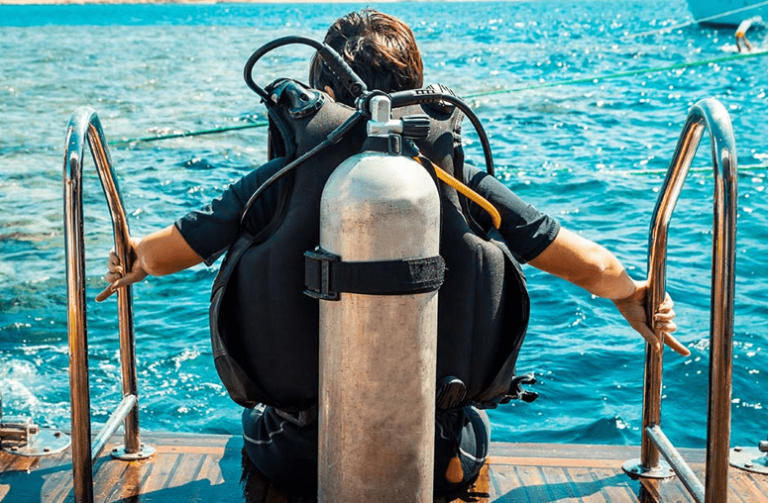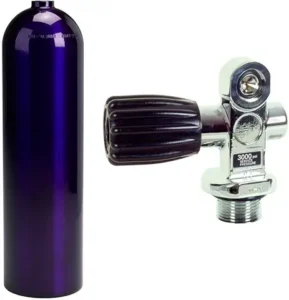Understanding Different Types of Scuba Dive Tanks

When it comes to scuba diving, choosing the right dive tank is crucial for ensuring a safe and enjoyable underwater experience. Dive tanks come in various materials, sizes, and designs, each with its own set of pros and cons. This blog will help you understand the different types of scuba dive tanks, their features, and which ones are best suited for your diving needs.
Material Options: Aluminum vs. Steel
Aluminum Dive Tanks
Pros:
Corrosion Resistance: Aluminum tanks are less prone to rust, making them ideal for use in saltwater environments.
Cost-Effective: Generally, aluminum tanks are more affordable than steel tanks.
Buoyancy: These tanks are more buoyant, which can be an advantage for certain diving situations, particularly when ascending or during safety stops.
Cons:
Weight: Aluminum tanks are typically heavier on land but become positively buoyant as they empty, which may require more weight to be added to your dive belt.
Durability: Aluminum is softer than steel, making these tanks more prone to dents and damage.
Steel Dive Tanks
Pros:
Durability: Steel tanks are more robust and can withstand rough handling better than aluminum tanks.
Weight and Buoyancy: Steel tanks are negatively buoyant even when empty, which can reduce the amount of lead weight a diver needs to carry.
Size Efficiency: Steel tanks can hold more air in a smaller size compared to aluminum tanks, making them more compact and easier to handle underwater.
Cons:
Corrosion: Steel tanks are susceptible to rust if not properly maintained, especially when exposed to saltwater.
Cost: They are generally more expensive than aluminum tanks.
Size Options for Scuba Diving
Dive tanks come in various sizes, typically measured in cubic feet (cf) in the US and liters (L) in other parts of the world. The most common sizes include:
- 80 cf / 11.1 L (Aluminum 80): The standard size for recreational diving, offering a good balance between air capacity and weight.
- 63 cf / 9 L: Smaller and lighter, suitable for shorter dives or divers who use less air.
- 100 cf / 15 L: Provides more air, ideal for deeper or longer dives, but heavier to carry.
- 50 cf / 7.1 L: Lightweight and compact, often used as pony bottles or for shallow dives.
- 120 cf / 17 L: Offers the highest capacity for extended dives but is the heaviest and largest option.
Ranking the 4 Best Dive Tanks for Scuba Diving
Customer Feedback: Divers praise the Faber HP Steel 100 for its high air capacity and negative buoyancy. Many users appreciate its compact design and durability.
Why It’s Great: The Faber HP Steel 100 offers an excellent balance of high capacity and compact size, making it ideal for longer or deeper dives. Its negative buoyancy reduces the need for additional weight, enhancing comfort and balance underwater. Made from high-quality steel, this tank is durable and robust, perfect for frequent divers.
Customer Feedback: Users love the Catalina S80 Aluminum for its affordability and wide availability. Many divers highlight its resistance to corrosion and ease of use.
Why It’s Great: The Catalina S80 Aluminum is a popular choice for recreational divers due to its good balance between air capacity and weight. It is resistant to corrosion, making it suitable for saltwater environments. This tank is also cost-effective, providing excellent value for both novice and experienced divers.
Customer Feedback: Divers appreciate the Faber LP Steel 85 for its durability and buoyancy characteristics. It is often recommended for its compact size and efficient air capacity.
Why It’s Great: The Faber LP Steel 85 combines durability and efficient air capacity in a compact design. Its negative buoyancy helps reduce the amount of lead weight needed, providing better balance and comfort underwater. This tank is suitable for a wide range of diving conditions and is built to last.
Customer Feedback: The Sea Pearls 80 Aluminum is favored for its lightweight and corrosion-resistant design. Divers often mention its ease of handling and versatility.
Why It’s Great: The Sea Pearls 80 Aluminum is lightweight and easy to handle, making it an excellent choice for both recreational and technical divers. Its corrosion-resistant design ensures durability in saltwater environments. This tank provides a good balance between air capacity and weight, making it versatile for various diving conditions.
Editor’s Choice: Faber HP Steel 100
Why It’s the Best:
High Capacity: With 100 cf of air, this tank offers extended dive times, making it ideal for longer or deeper dives.
Compact Design: Despite its high capacity, the Faber HP Steel 100 is relatively compact, making it easier to handle and maneuver underwater.
Negative Buoyancy: This tank is negatively buoyant even when empty, reducing the amount of lead weight you need to carry, which enhances comfort and balance.
Durability: Made from high-quality steel, this tank is robust and can withstand the rigors of frequent diving.
Versatility: Suitable for both recreational and technical diving, the Faber HP Steel 100 is a versatile choice that meets the needs of a wide range of divers.
Tips to Maintain a Dive Tank
- Rinse After Each Dive: Always rinse your dive tank with fresh water after each dive to remove salt, sand, and other debris. This helps prevent corrosion, especially for steel tanks.
- Store Properly: Store your dive tank in a cool, dry place away from direct sunlight. Ensure the tank is upright to avoid damaging the valve or causing internal moisture buildup.
- Regular Inspections: Have your tank inspected annually by a certified technician to check for any signs of wear, corrosion, or damage. Follow the manufacturer’s recommendations for hydrostatic testing intervals.
- Keep It Pressurized: Store the tank with a small amount of air pressure (around 200 psi) to prevent moisture from entering and causing internal corrosion.
- Valve Maintenance: Regularly check and maintain the tank valve to ensure it is functioning properly. Lubricate the valve threads with appropriate silicone grease to prevent sticking.
Dive Tank Accessories
Enhance your diving experience with these essential dive tank accessories:
- Tank Boot: A tank boot provides stability when the tank is standing upright and protects the bottom from damage.
- Tank Mesh Protector: A mesh protector helps prevent scratches and dings on the tank’s surface, extending its lifespan.
- Tank Bands and Straps: These secure the tank to your buoyancy control device (BCD), ensuring it stays in place during the dive.
- Tank Pressure Checker: A pressure checker allows you to monitor the tank’s air pressure before and after dives, ensuring you always have enough air for your dive plan.
- Tank Valve Cap: A valve cap protects the tank valve from dirt and debris when not in use, keeping it clean and functional.
Tips for Using Dive Tanks Underwater
- Proper Maintenance: Regularly inspect and maintain your dive tank to ensure it remains in good condition. Rinse it with fresh water after each dive, especially if you’ve been in saltwater.
- Check Buoyancy: Be aware of your tank’s buoyancy characteristics and adjust your weight system accordingly to maintain proper balance and trim.
- Monitor Air Supply: Always keep an eye on your air gauge and plan your dive to ensure you have enough air for a safe ascent, including a safety stop.
- Secure Your Tank: Ensure your tank is securely fastened to your BCD to prevent it from shifting during the dive, which can affect your buoyancy and balance.
- Use the Right Size: Choose a tank size that matches your air consumption rate and the type of dive you’re planning. Larger tanks are suitable for longer or deeper dives, while smaller tanks are ideal for shorter or shallower dives.
Choosing the right scuba dive tank can significantly enhance your diving experience, providing the necessary air supply and ensuring comfort and safety underwater. By understanding the differences between aluminum and steel tanks, as well as the various size options, you can select the perfect tank for your diving needs. The Faber HP Steel 100 stands out as the Editor’s Choice for its excellent balance of capacity, durability, and buoyancy, making it a top pick for divers of all levels.




